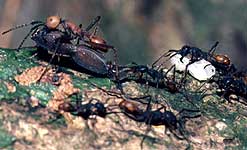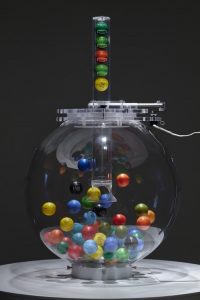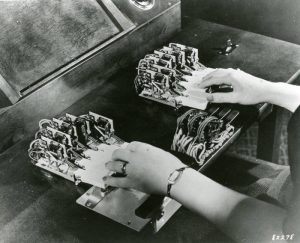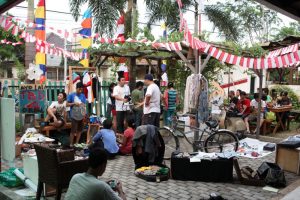Scientists are studying ants behaviour to help solve technical problems.
An ant can work out the quickest way from A to B more efficiently than a boffin with a computer. It bases its behaviour on pheromone trails laid down by its nest-mates. So now human communications networks are often based on virtual pheromone trails.
 Nigel Franks, of the University of Bristol, keeps ant colonies in plastic boxes, and paints his ants different colours so he can watch what each one does.
Nigel Franks, of the University of Bristol, keeps ant colonies in plastic boxes, and paints his ants different colours so he can watch what each one does.
“Army ant colonies are huge, so they have real traffic-flow problems, but it seems that evolution has programmed them with exactly the right rules of motorist behaviour so that they automatically form lanes.” (…) “the ants that are unburdened, that are running out to the swarm-front to find new prey-items, can run more quickly because they’re not carrying anything, and they form two express lanes on either side of the main trail, whereas all the ants coming back with food take a central lane.”
Researchers at Intelligent Autonomous Systems Laboratory at the University of the West of England have built up a fleet of U-Bots inspired by ants. The bots glide around an arena carrying a U-shaped scoop and gather together frisbees and assemble them in a pile in the centre of their arena. Like ants, they individually appear limited in their behavioural repertoire yet groups have the ability to build sophisticated structures and display emergent self-organisation.
![DSCF0035a[1].jpg](http://www.we-make-money-not-art.com/yyy/DSCF0035a%5B1%5D.jpg) Chris Melhuish explains: “If we want to build very small robots, there will be problems in getting computation on board, and sensing and communication.
Chris Melhuish explains: “If we want to build very small robots, there will be problems in getting computation on board, and sensing and communication.
“Being small is going to be a problem. So how can you get a whole bunch of dumb small things doing something smart?
“And that’s why these techniques, borrowed from the ants, can be exploited to make very small robots. It would be nice to think that we could use nano-robots to carry out repair work inside the human body, but it’s early days.”
Via BBC News.







